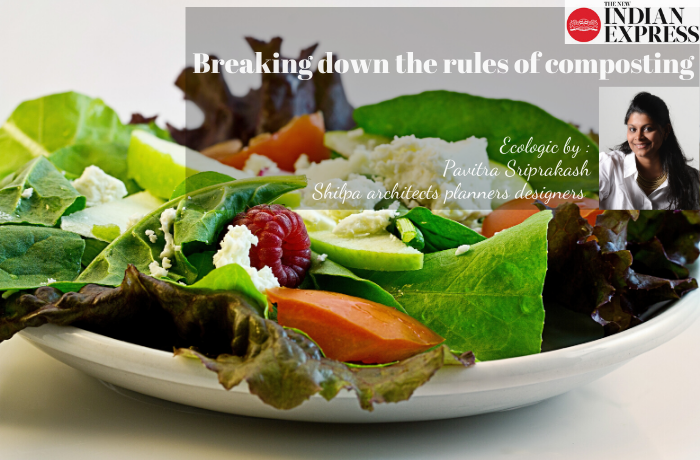20-Nov-2019 : Pavitra Sriprakash, Director and Chief Designer at Shilpa Architects Planners Designers writes a weekly column on Sustainability for The New Indian Express titled “ECOLOGIC”. This week she writes about the benefits of composting at home.
Full article below: (Also available at The New Indian Express Website)
Breaking down the rules of composting
Chennai has made segregation of waste mandatory for all homes. While this move helps to reduce the amount of waste going into landfill by separating dry waste — which can then be properly recycled, what happens to our kitchen and organic waste? There is no need for us to wrap these in plastic and send them to the local dump-yards — composting at home can help us cut back further on our addition to our landfills and give us rich manure in the process. Composting is a display of nature’s recycling at its
very best. In layman terms it is the process of rotting or decomposition of organic matter by microorganisms.
The difference being that under controlled conditions, we can harvest the result of this process and use it for purposes that serve to our advantage. Raw organic materials such as kitchen and garden waste are easily compostable. Treating these organic wastes at home is a sure-shot way to divert 25- 50 per cent of people’s average daily household waste away from landfills. Garden waste and food waste that sits in the landfill decomposes and releases methane, a potent greenhouse gas. While more advanced landfills capture and re-use this methane, eliminating the gas at its source is an even better route to adopt.
Composting that can be practised at home can be broadly classified as aerobic composting and worm composting (vermicomposting). Aerobic composting is the most natural method of recycling wherein the waste is broken down through exposure to air. This is particularly useful in the case of garden waste such as fallen leaves, hedge trimmings etc.
Aerobic composting takes place in the presence of ample oxygen. In this process, aerobic microorganisms break down organic matter and produce carbon dioxide (CO2), ammonia, water, heat and humus — the organic end product. A large compost pit can be dug in the yard, lined with some coir and filled with garden waste. Lime is added as a starter as it is thought to weaken the lignin structure of the plant materials and enhance the microbial population. It also helps to downsize or chop up larger segments. It increases the surface area available and provides better aeration. This technique is particularly effective and necessary for harder materials such as wood.
Worm composting is achieved through the enzymatic degradation of organic materials as they pass through the digestive system of earthworms.
This method transforms waste into very high-quality compost. This is probably the best way of composting kitchen wastes. Many systems are available for these controlled and aerated ‘worm farms’. The commercial models are usually made of materials that allow the system to ‘breathe like wood or terracotta. Plastic is also used in some systems but is generally not preferred due to its on-breathability.
There are many benefits to composting that could add to the overall feel-good factor of this activity. Apart from improving an individual’s carbon footprint, many savings are possible — in water, energy and money.
When you produce compost at home, you don’t need to buy as much manure or other rich food for the plants from the nursery, thereby saving money as well. Not too shabby!



